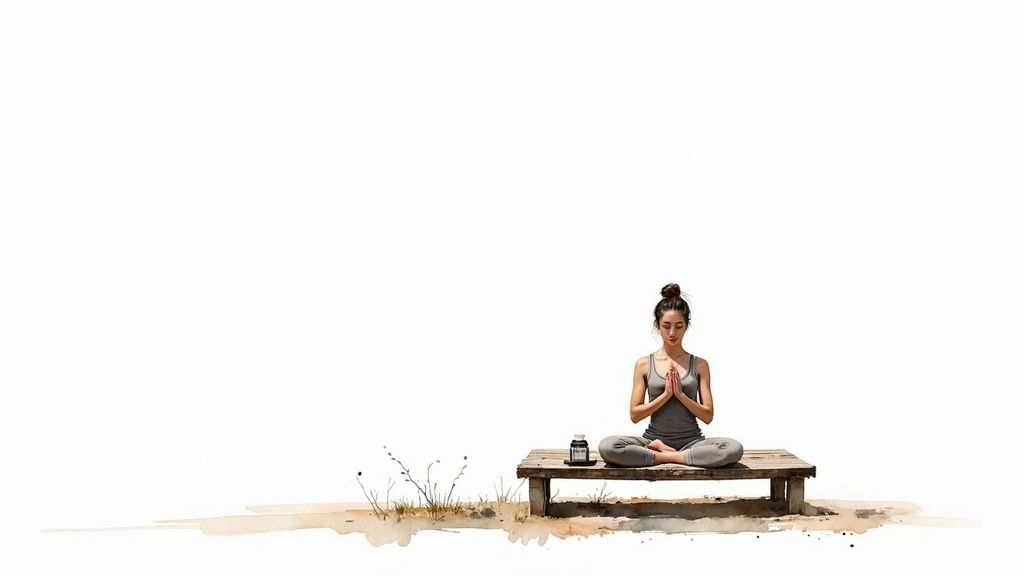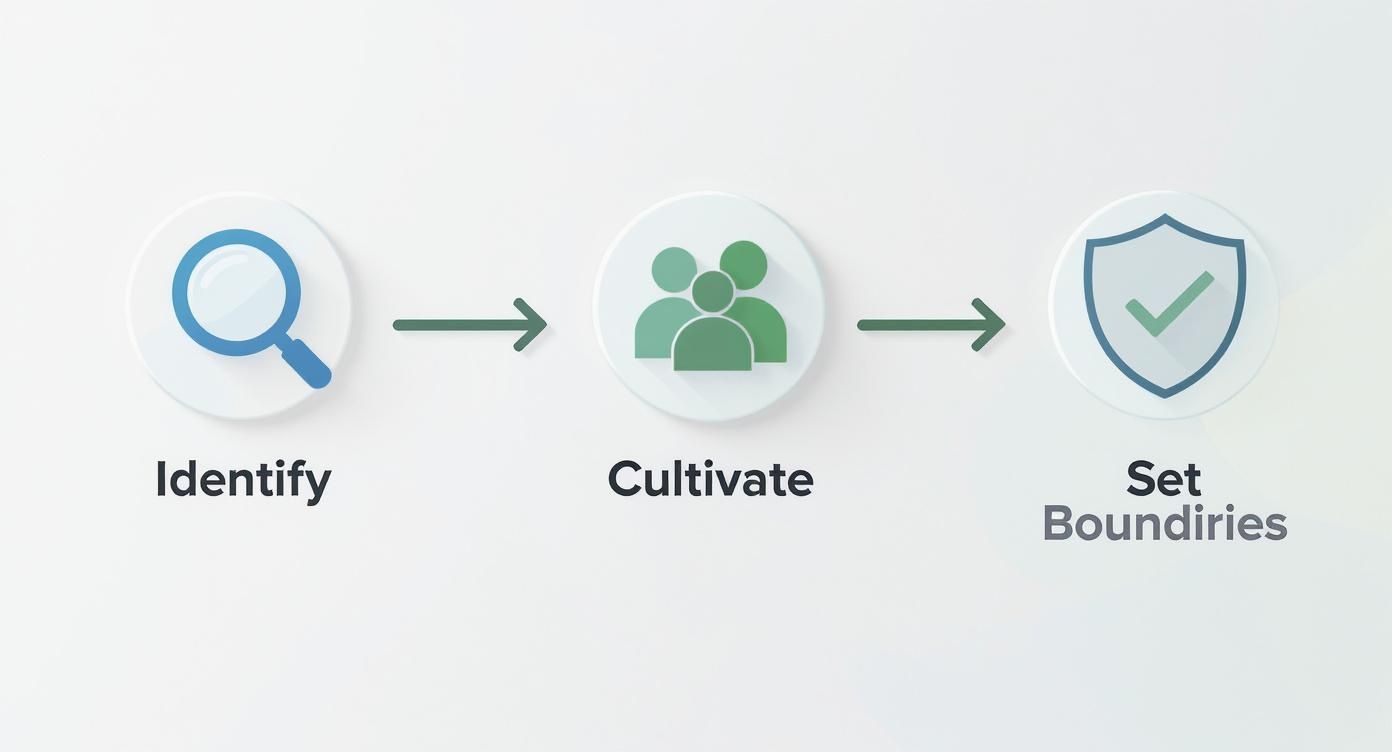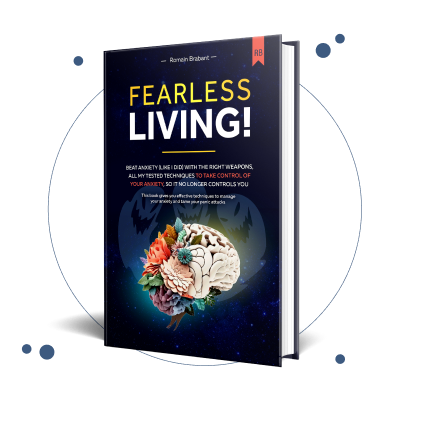
When you're caught in the relentless grip of chronic stress, it feels less like a temporary storm and more like a permanent weather system you can't escape. But I want to be clear: recovery isn't just a hopeful idea. It's an achievable path you can start walking today. Healing from anxiety and living a panic-free life is absolutely possible, and it begins with taking small, deliberate steps away from the overwhelm.
Your First Steps Away from Overwhelm

When you’re living in a constant state of high alert, the idea of "recovery" can feel monumental, even impossible. But you don’t need to solve everything at once. The journey back to calm begins with small, immediate actions that prove you can regain control and show you that a life free from panic is within your reach.
Think of this section as your emergency toolkit. It’s designed to de-escalate that overwhelming feeling and restore a sense of calm right now. This isn't about ignoring the root causes—we'll get to that. It's about giving yourself the breathing room you need to even think about tackling them later. These strategies are anchors in a turbulent sea; they won’t stop the storm, but they will keep your head above water and remind you that you are capable of finding safety.
Gently Assess Your Starting Point
Before diving into solutions, let’s take a gentle, non-judgmental look at where you are right now. Chronic stress isn't just a feeling; it’s a physiological state that leaves real fingerprints on your body and mind.
Recognizing the signs is the first, powerful step toward healing. Do any of these sound familiar?
- Physical Tension: Do you notice persistent tightness in your jaw, shoulders, or neck? That’s your body, quite literally, holding onto stress.
- Sleep Disruption: Are you struggling to fall asleep, stay asleep, or waking up feeling exhausted even after a full night's rest?
- Emotional Reactivity: Do you find yourself snapping at loved ones over small things or feeling constantly on edge? This is a classic sign your nervous system is overloaded.
- Cognitive Fog: Is it difficult to concentrate, make decisions, or remember details? Chronic stress tanks your executive function.
Seeing these symptoms for what they are—a recognized response to prolonged pressure, not a personal failing—is incredibly validating. It’s a shared human experience, especially in recent years. Globally, emotional stress shot up by 12.5% during the pandemic compared to the 2008 financial crisis, which shows just how widespread this challenge has become. You are not alone in this.
To get started right away, here's a quick reference table with some foundational actions you can take immediately.
Immediate Stress Relief Action Plan
| Action | Why It Helps | Simple First Step |
|---|---|---|
| Deep Breathing | Activates the parasympathetic nervous system, signaling your body to calm down and feel safe. | Inhale for 4 counts, hold for 4, exhale for 6. Repeat 3 times. |
| Grounding | Pulls your focus out of anxious thoughts and into the present moment, proving you can find stability. | Name 3 things you can see and 2 things you can hear right now. |
| Mindful Movement | Releases physical tension and endorphins, which are natural mood boosters that remind you what calm feels like. | Stand up and stretch your arms overhead for 30 seconds. |
| Sensory Soothing | Engages your senses to interrupt the stress cycle and provide immediate comfort and a feeling of control. | Sip a warm, non-caffeinated drink like herbal tea or warm water. |
This table isn't a cure-all, but each action is a small, powerful way to interrupt the stress response and reclaim a sense of control, proving to yourself, moment by moment, that you can heal.
Immediate Grounding Techniques for In-the-Moment Relief
When anxiety spikes and panic feels like it's just around the corner, you need a quick, reliable way to anchor yourself. Grounding techniques are designed to pull you out of the chaotic storm in your mind and back into the safety of the present moment. Their entire purpose is to interrupt the panic cycle before it takes hold, showing you that you have the power to stop it.
One of the most effective and discreet methods is the 5-4-3-2-1 technique. You can do it anywhere, anytime.
The 5-4-3-2-1 Grounding Method
- Look for 5 things you can see: Name five distinct objects around you. A blue pen, a crack in the ceiling, a spinning fan. Get specific.
- Feel 4 things you can touch: Notice the texture of your jeans, the smoothness of your desk, the warmth of your own skin.
- Listen for 3 things you can hear: Tune into sounds you might normally ignore—the hum of a computer, distant traffic, your own breathing.
- Notice 2 things you can smell: Can you detect the faint scent of coffee, hand soap, or the fresh air from an open window?
- Acknowledge 1 thing you can taste: Focus on the lingering taste of your last meal, or simply the neutral taste inside your mouth.
This exercise works because it forces your brain to shift focus from internal worry to external sensory input, which directly calms the nervous system. It's a powerful reminder that you have agency over your attention and can guide yourself back to safety.
If you’re looking for more ways to manage acute anxiety, these other grounding techniques for anxiety can be incredibly helpful. And for a more holistic approach, exploring methods like tension and trauma releasing techniques can be a game-changer in processing stored stress.
Building Your Daily Recovery Routine

Real, lasting recovery from chronic stress doesn’t happen through grand, one-off gestures. It’s forged in the quiet consistency of your daily choices. Forget the idea of a dramatic overhaul. Instead, think of it like tending a garden—small, steady actions cultivate resilience and give you a much-needed sense of control when life feels overwhelming. This is how you build a panic-free life.
This daily routine is your personal ecosystem for healing. We’re going to focus on the three pillars of resilience that matter most: sleep, nutrition, and movement. By making small, intentional shifts here, you build a powerful foundation that helps your nervous system find its way back to balance. The goal isn't perfection. It’s gentle, consistent progress that builds hope.
Reclaiming Restful Sleep
Chronic stress wages a direct war on your sleep. When you’re constantly on edge, your body is flooded with cortisol, the primary stress hormone. This disrupts your natural sleep-wake cycle, making it tough to fall asleep, stay asleep, or wake up feeling anything other than exhausted. Sound familiar? Your body is tired, but your mind just won't shut off.
This isn’t just about hitting the eight-hour mark. It’s about improving the quality of your rest so your brain and body can actually do their nightly repair work, which is a vital part of healing.
Simple Strategies for Better Sleep:
- Create a "Wind-Down" Buffer: An hour before you plan to sleep, dim the lights and put away the screens. That blue light from your phone or TV is notorious for suppressing melatonin, the hormone that tells your body it's time to rest.
- Make Your Bedroom a Sanctuary: Your body temperature naturally drops to initiate sleep. Keep your room cool and as dark as possible to support this process. Think of it as a cave—cool, dark, and safe.
- Mind Your Evening Stimulants: This goes beyond just caffeine after 2 PM. Try to avoid intense, stressful conversations or doomscrolling the news right before bed. Your nervous system needs a chance to downshift.
These little rituals do more than just get you ready for bed. They send a powerful signal to your brain that the day’s threats are over and it's finally safe to rest. This is a crucial step in learning how to recover from chronic stress and feel hopeful about tomorrow.
Nourishing Your Nervous System
When you're running on fumes, it’s so easy to reach for comfort foods loaded with sugar, unhealthy fats, and caffeine. They give you a quick hit of relief, sure, but they often spike your cortisol and blood sugar, leaving you feeling more anxious and depleted in the long run.
The key isn't a restrictive diet. It’s about gently crowding out the unhelpful stuff with foods that actively support your nervous system. Think of every meal as an opportunity to give your body the building blocks for calm.
Foods that Calm vs. Foods that Agitate
| Calming Foods to Include | Agitating Foods to Limit |
|---|---|
| Magnesium-Rich Foods: Leafy greens like spinach and kale, nuts, seeds, and even dark chocolate help regulate cortisol and promote a sense of calm. | Refined Sugars & Carbs: Candy, pastries, and white bread cause blood sugar to spike and then crash, which can mimic and worsen anxiety symptoms. |
| Omega-3 Fatty Acids: Found in salmon, walnuts, and flaxseeds, these healthy fats are fantastic for reducing inflammation and supporting brain health. | Excessive Caffeine: That morning coffee is fine for most, but high doses throughout the day can completely overstimulate an already fried nervous system. |
| Complex Carbohydrates: Foods like oats, brown rice, and sweet potatoes provide a slow, steady release of energy and help produce serotonin. | Processed Foods: Often packed with unhealthy fats and additives, they can contribute to inflammation and mood swings. |
Making a simple swap—like grabbing a handful of almonds instead of a sugary granola bar—is a small but meaningful act of self-care. It reinforces the message that you are an active participant in your own healing journey.
Redefining Movement as a Tool for Release
For many of us dealing with stress, "exercise" sounds like just another exhausting chore on an already mile-long to-do list. Let's reframe that. Movement isn't about punishment or pushing your limits; it’s a biological tool for clearing stress hormones out of your system and boosting mood-lifting endorphins. It’s a direct way to help your body feel better.
When your nervous system is on high alert, gentle and mindful movement is often far more beneficial than a high-intensity workout. The focus here is on reconnecting with your body in a compassionate, non-judgmental way.
Gentle Practices for Stress Release:
- A 15-Minute Walk: Getting outside for a short walk, especially in nature, is proven to lower cortisol. It helps you process your thoughts without feeling stuck inside your own head.
- Simple Stretching: When you wake up or before bed, spend just five minutes stretching the places where stress loves to hide—your neck, shoulders, and hips.
- Mindful Meditation: You don't need to sit for an hour. Even a few minutes of quiet sitting can have a profound impact. If you're new to this, our guide on meditation for anxiety is a great place to start.
Fitting these practices into your day doesn’t require a huge time commitment. To keep it all manageable, you might want to use the best daily planner app to block out small pockets of time just for you. By scheduling your recovery, you make it a priority and build unstoppable momentum toward a calmer, more hopeful life.
Rewiring Your Thoughts to Calm Your Mind

Chronic stress does more than just make you feel overwhelmed; it actually changes how your brain works. It trains your mind to constantly scan for danger, locking you into a cycle where anxiety feels like the default setting and panic is always just around the corner.
But here’s the most hopeful part: this wiring isn't permanent. You have the power to gently create new neural pathways, and it all starts with getting curious about your own thoughts.
This process is about reclaiming your mental space. It’s not about forcing yourself to "think positive," which can feel completely dismissive when you're struggling. Instead, it’s about learning to observe your thoughts, question their validity, and slowly build a more compassionate inner dialogue. This is how you learn to live a panic-free life—not by eliminating stress, but by changing your relationship with it.
Identifying Automatic Negative Thoughts
The first real step is becoming aware of the automatic negative thoughts (ANTs) that are fueling your stress. These are the quick, reflexive, and often critical judgments that pop into your head without any conscious effort. They feel like facts, but they’re usually just old, unhelpful stories your brain has learned to tell itself.
For example, you make a small mistake at work, and an ANT immediately screams, "I'm going to get fired." That single thought can trigger a full-blown physical stress response—racing heart, shallow breathing, a knot in your stomach. Learning to simply catch these thoughts is the first step toward disarming them and taking back your power.
This mental work is a core part of recovery, but it’s crucial to remember the mind-body connection. The impact of stress isn’t just psychological. A 2023 APA survey revealed that chronic illnesses in adults aged 35 to 44 jumped from 48% in 2019 to 58% in 2023, while mental health diagnoses rose from 31% to 45%. You can explore more about these findings on collective trauma recovery from the American Psychological Association.
Questioning Your Anxious Mind with CBT
Once you start noticing these thoughts, you can begin to gently question them using principles from Cognitive Behavioral Therapy (CBT). CBT is a well-researched approach that gives you a structured way to challenge the distorted thinking patterns and break the thought loops that keep you stuck, opening the door to a more peaceful mind.
Think of it like being a gentle detective for your own mind. When a stressful thought pops up, instead of just accepting it as the absolute truth, you can ask a few simple questions:
- Is this thought 100% true? Is it a fact, or is it my interpretation of the facts?
- What’s a more balanced or compassionate way to look at this situation?
- What would I tell a friend who was having this exact thought?
This process isn't about arguing with yourself. It's about creating just a sliver of space between you and the thought, which is often enough to lessen its emotional power. If you’re interested in a deeper dive, you can learn more about understanding CBT for anxiety in our detailed guide.
This gentle questioning is a skill that gets stronger over time. At first, it might feel awkward or forced. But with consistent practice, you are actively rewiring your brain to be less reactive and more resilient. You're teaching it that not every anxious thought requires a full-blown emergency response, paving the way for lasting calm.
The Calming Power of Mindful Breathing
While that cognitive work is powerful, sometimes you need a tool that works right now, especially when panic starts to rise. This is where mindful breathing comes in. It’s not just about taking a deep breath; it’s about using your breath as an anchor to the present moment, a safe harbor you can always return to.
When you're anxious, your breathing becomes shallow and rapid, signaling to your brain that there's danger. By intentionally slowing your breath, you send the opposite signal: "I am safe."
A Simple Guided Breathing Exercise:
- Find a comfortable position, either sitting or lying down.
- Gently close your eyes or soften your gaze.
- Inhale slowly through your nose for a count of four, feeling your belly expand.
- Hold your breath gently for a count of four.
- Exhale slowly and completely through your mouth for a count of six.
- Repeat this cycle for just one or two minutes.
This technique activates your parasympathetic nervous system—your body's natural "rest and digest" response. It's an incredibly effective way to soothe a panic response in minutes and is a vital skill for anyone learning how to recover from chronic stress and build a life with more peace.
Untangling Your Worries with Journaling
Finally, journaling is a simple, practical way to get all those swirling, chaotic thoughts out of your head and onto paper. The simple act of writing creates distance and perspective. When worries are written down, they often seem more manageable and less threatening than when they're just bouncing around in your mind.
You don’t need to write pages and pages. A simple "thought dump" at the end of the day can be incredibly effective. Just write down whatever is on your mind without judgment or editing. This practice helps you identify recurring thought patterns and gives your mind permission to let go, paving the way for more restful sleep and a calmer, more hopeful tomorrow.
The Power of Connection and Healthy Boundaries
Let's be honest: trying to heal from chronic stress in a vacuum is a losing battle. While all the internal work is essential, your external world—especially the people in it—can either supercharge your recovery or drain you dry. Trying to get better in an unsupportive environment is like trying to row a boat with a hole in it. It’s exhausting, and you don’t get very far.
This is where human connection comes in. We are wired for community. Real, authentic support isn't just a nice-to-have; it’s a powerful antidote to the profound isolation that chronic stress creates. But here's the catch: connection without boundaries can quickly become just another source of stress. The real skill is learning to build a personal ecosystem that truly nurtures your healing.
Cultivating Your Support System
First, it’s time for an honest inventory of your relationships. Who in your life makes you feel seen, heard, and genuinely safe? These are your anchors. They're the friends who listen without trying to "fix" you, the family members who offer practical help, or the partner whose presence is a comfort.
On the flip side, you have to identify the relationships that consistently leave you feeling drained, anxious, or small. This doesn't mean you need to start cutting people out of your life tomorrow, but awareness is everything. Your energy is a finite resource, especially during recovery. You have to start protecting it fiercely so you have more for your own healing.
How to nurture your connections:
- Be Intentional: Schedule regular, low-pressure time with the people who lift you up. It doesn't have to be a big production—a 15-minute phone call or a quiet coffee can make all the difference.
- Practice Vulnerability (Slowly): Start by sharing small feelings or a minor struggle with a trusted friend. This is how you build real intimacy and show them how they can be there for you.
- Say Thank You: A simple, "Thanks for listening, that really helped," reinforces that positive connection and makes people feel good about supporting you.
This isn't just a feel-good exercise. Creating a supportive network is a biological necessity for healing. Feeling socially connected directly calms your nervous system and serves as a constant reminder that you are not alone in this and that a better future is possible.
Learning the Art of Healthy Boundaries
Boundaries are not walls you build to push people away. Think of them as loving limits you set to protect your own well-being. For anyone recovering from chronic stress, the word "no" is one of the most powerful healing tools in your arsenal. It frees up precious energy that you can redirect toward your own recovery.
I get it—setting boundaries can feel terrifying at first, especially if you've spent your life as a people-pleaser. You worry about disappointing people or coming across as selfish. But you have to remember this: you cannot pour from an empty cup. You deserve to heal.
For instance, a friend asks you to help them move on a Saturday, but you know you desperately need that day to rest and recharge. Saying "no" isn't selfish—it's essential self-preservation. This is a non-negotiable part of learning how to recover from chronic stress.
Practical Phrases for Setting Boundaries
Sometimes, just having the right words ready can make all the difference. It helps you communicate your needs clearly and kindly, without feeling like you're starting a conflict.
| Situation | Unclear Boundary | Clear & Kind Boundary |
|---|---|---|
| An extra work project | "I guess I can try to fit it in…" | "I appreciate you thinking of me, but I can't take on anything new right now to protect my workload." |
| A social gathering | "I'll try to make it, but I'm tired." | "Thank you so much for the invitation! I need a quiet night in to recharge, but I hope you have a wonderful time." |
| A friend who vents excessively | (Silently feeling overwhelmed) | "I want to be here for you, but I only have the emotional energy for a 10-minute chat right now. Can that work?" |
Communicating your needs is also vital in romantic relationships, where stress can easily create friction. If this is a sore spot, our guide on navigating love versus anxiety in a relationship offers more specific strategies.
And the evidence for this is strong. Recovery from chronic stress isn't just psychological; it's deeply tied to our biology and social lives. Feeling supported by family and friends significantly reduces risk, and studies show that up to 40% of people with severe stress disorders can recover within a year with the right support system in place. You can learn more about these hopeful recovery statistics from the World Health Organization.
Creating a Sustainable Path to Long-Term Wellness
Getting over chronic stress isn’t like crossing a finish line. It’s more like learning to walk a new path every single day—one that’s going to have its share of smooth stretches and unexpected bumps.
This is where real hope comes from. It's not about chasing a fantasy of a stress-free life, but about building confidence that you have the tools to handle whatever comes your way. This section is your roadmap for the long haul. We're shifting from quick fixes to building a sustainable lifestyle of calm, resilience, and lasting freedom from panic.
Recognizing Your Personal Stress Triggers
To keep from slipping back into old patterns, you first need to become an expert on yourself. Chronic stress has a sneaky way of blending into the background, making it tough to pinpoint what exactly sends your nervous system into a tailspin.
Think of yourself as a gentle detective investigating your own life. What specific situations, people, or even thought patterns usually show up right before you feel overwhelmed?
- Is it that Sunday evening dread before a hectic work week?
- A particular family member who always seems to drain your energy?
- The internal pressure you put on yourself to be perfect?
Just naming your triggers strips them of their power. It shifts you from feeling like a passive victim of stress to an active observer who can see challenges coming and prepare for them. This awareness is the foundation of a panic-free life and gives you a powerful sense of control over your own well-being.
Creating Your Personalized Stress Flare-Up Plan
Even with the best strategies, some days will just be hard. A tough meeting, a piece of bad news, or simple exhaustion can throw you off balance. Instead of getting discouraged, you can be ready with a go-to action plan. This is a sign of resilience, not failure.
Your "Stress Flare-Up Plan" is a short, pre-written list of things you can do the moment you feel that familiar spike of overwhelm. The trick is to make this list when you're feeling calm, so you don't have to think when you're already frazzled.
This plan is your personal first-aid kit for emotional distress. It’s a compassionate and practical tool that reminds you exactly what to do when you feel lost, ensuring you never have to start from scratch. It is a testament to your commitment to healing.
Your plan could be a mix of grounding techniques, soothing activities, and helpful reminders. Here’s what one might look like:
My Go-To Stress Flare-Up Plan
- Immediate Action: Step away from what I'm doing. Go to another room or get outside for five minutes.
- Breathe: Do the 4-6 breathing exercise (inhale for 4, exhale for 6) for two full minutes.
- Engage Senses: Hold an ice cube or splash my face with cold water to ground myself.
- Reach Out: Send a quick text to my supportive friend, Sarah, just to connect.
- Self-Talk: Remind myself, "This feeling is temporary. I can handle this and I am safe."
Building a support system is an active process. You need to identify the right people, nurture those relationships, and also protect yourself by setting boundaries when needed. It's a crucial part of any long-term recovery strategy.

This process is about more than just having people to call; it's about intentionally creating a network that can hold you up during the tough moments and celebrate your progress with you.
Tracking Progress with Self-Compassion
When you're learning how to recover from chronic stress, it’s tempting to measure success with rigid numbers. But healing isn't a checklist. Instead of focusing on "how many panic attacks did I have this week," try tracking the positives with a much gentler, more hopeful approach.
Start noticing the small but profound shifts in your daily life. That’s where you’ll find the most encouraging proof that you're making progress toward a panic-free life.
Signs of Healing to Look For:
- Improved Mood: Are you having more moments of contentment, joy, or even simple peace?
- Increased Energy: Do you find you have a little more in the tank to get through your day?
- Better Sleep: Are you falling asleep more easily or waking up feeling a bit more rested?
- Greater Resilience: Did you handle a stressful moment this week better than you would have a few months ago?
Jotting these small wins down in a journal can be incredibly motivating. It builds a powerful library of evidence that you are, in fact, getting better. And don't forget that your diet and lifestyle play a huge role in your energy and mood. For more on this, you can explore specific lifestyle and diet changes for anxiety management that support your nervous system.
This journey is about progress, not perfection. Every small step forward is a victory, reinforcing the hopeful truth that a calmer, more resilient life is not only possible but is already unfolding for you.
Got Questions? Let's Talk About Stress Recovery
Starting this journey can bring up a lot of questions. You might be wondering if you can really heal or how long it’s all going to take. Let's tackle some of the most common concerns with real, straightforward answers to help you feel more grounded and hopeful as you move forward.
The path ahead is all about self-compassion and taking small, steady steps. Hope isn't just a feeling—it's the belief that your actions today will create a better, more peaceful tomorrow. You can heal.
How Long Does It Take to Truly Recover?
There’s no magic timeline here; recovery is a deeply personal process. Some people start to notice small shifts within a few weeks of consistent effort, while for others, it might take several months to feel a real, lasting change. The key is to stop focusing on a deadline and start celebrating the small wins along the way.
Did you handle a tough conversation better than you would have a month ago? Did you manage to get one extra hour of deep sleep? These are real, tangible signs of progress. Healing isn't a straight line—you’ll have good days and harder ones. The goal is a steady upward trend, not perfection. This gentle, persistent approach is at the heart of how to recover from chronic stress and find lasting freedom.
Can I Actually Do This Without Professional Help?
Absolutely. Many people find incredible relief by putting the lifestyle shifts, boundary-setting, and mental strategies from this guide into practice. A self-led recovery can be hugely empowering, and it’s entirely possible to heal and become panic-free.
That said, think of professional help—like therapy or medication—not as a last resort, but as powerful tools in your toolkit that can accelerate your healing. A good therapist can give you a personalized roadmap and unbiased support. Medication can help rebalance your system, making it easier to do the work. Deciding to get help is a sign of incredible strength and a real commitment to your well-being.
"If left untreated, chronic stress can slowly erode your physical, mental, and emotional wellbeing. The longer it goes unaddressed, the harder it becomes to bounce back—but it’s never too late to start healing. Recovery is always possible."
What's the Single Most Important Thing I Can Do Right Now?
If you do just one thing today, focus on your breath. It's the fastest, most direct way to hit the brakes on your body's stress response and prove to yourself that you have the power to create calm.
Try this simple exercise right now:
- Inhale slowly through your nose for a count of four.
- Hold your breath gently for another count of four.
- Exhale slowly and completely through your mouth for a count of six.
- Pause for a beat before taking the next breath.
Do this for just two minutes. This simple action flips on your parasympathetic nervous system, sending a clear signal to your brain that you're safe and it's okay to relax. It costs nothing, takes almost no time, and you can do it anywhere. It’s a powerful first step that proves you have the ability to find calm and begin your journey to a panic-free life, one breath at a time.
Ready to build a complete, personalized toolkit for a calmer, more fearless life? The Anxiety Checklist provides a step-by-step system with practical tools, cognitive strategies, and customizable worksheets to help you manage anxiety and live panic-free. Take control of your recovery journey and discover your path to sustained mental wellness at https://anxietychecklist.com.

